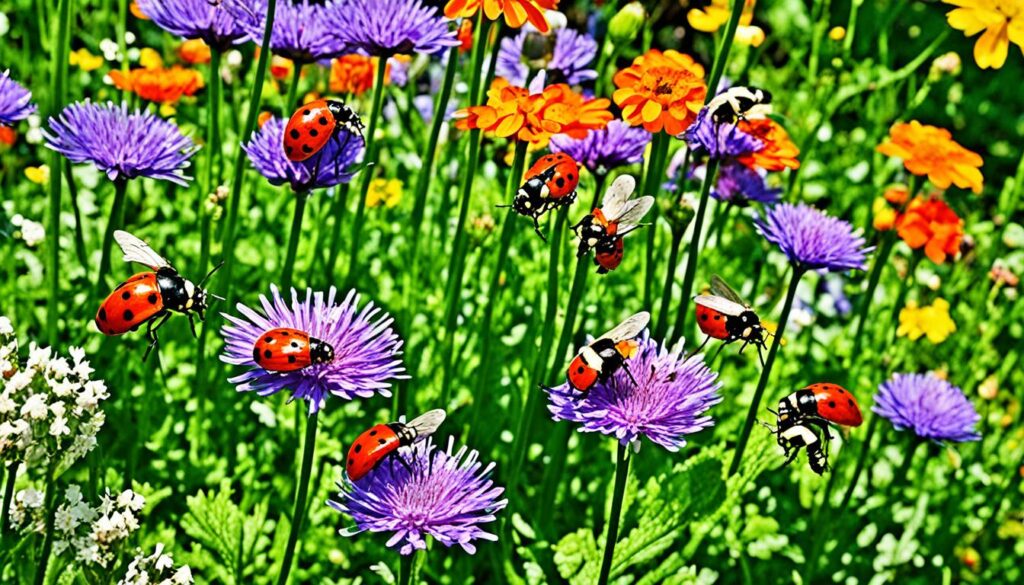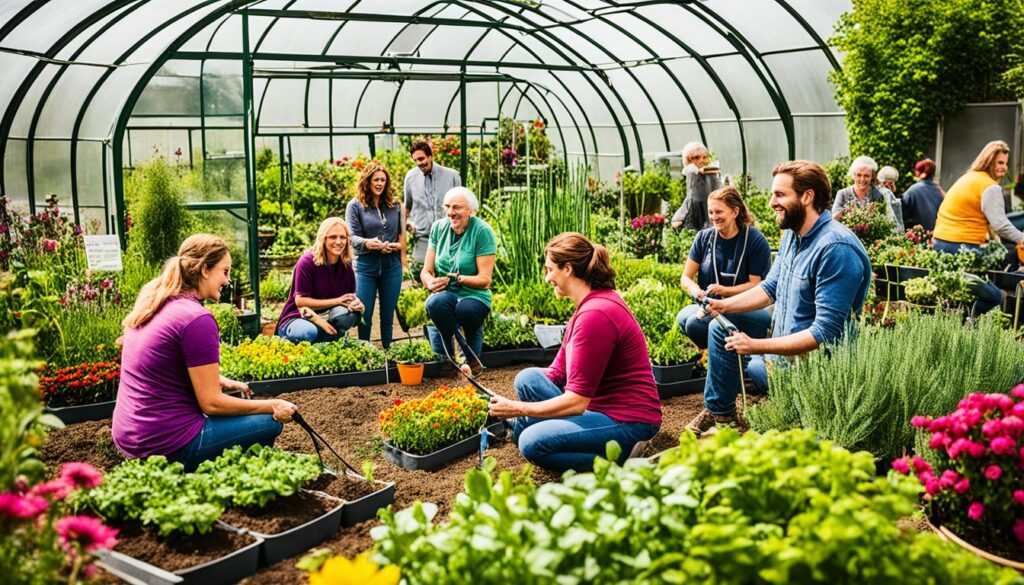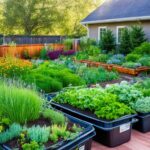Advanced Techniques in Sustainable Gardening
Ever thought about turning your garden into a lush, sustainable haven? It’s all about learning advanced gardening tricks that go way beyond the basics. By using eco-friendly methods, you can make a garden that’s not just pretty but also good for the planet. Get ready to discover how to create a garden full of veggies that will make everyone jealous.
Key Takeaways
- Discover cutting-edge sustainable gardening practices that optimize growth and minimize environmental impact.
- Learn how to curate a garden of distinction by making strategic seed choices.
- Explore precision planning and layout design techniques to maximize your garden’s visual appeal and efficiency.
- Delve into specialized soil and nutrient management strategies for a thriving, nutrient-rich garden.
- Uncover advanced watering techniques that conserve water and promote plant health.
Selective Seed Choices for Advanced Gardening
Moving from basic to advanced gardening is exciting and rewarding. It leads to a garden full of life and beauty. At Farmgokart, we know how much gardeners love to improve their skills. Check out our rare and captivating flower varieties to make your garden pop. Grow a mix of heirloom vegetable seeds for their unique taste and look. Add rare and unique outdoor plants to make your garden unforgettable.
Curating a garden of distinction with premium seeds:
Picking the right seeds is key to a standout garden. Whether you’re an expert or a beginner, our premium seeds open up new possibilities. Our rare flower varieties and heirloom vegetable seeds let you create a garden that shows off your style and tastes.
| Seed Type | Unique Features | Recommended Varieties |
|---|---|---|
| Flowers | Rare and exotic blooms, vibrant colors, unique petal shapes | Black Peony, Midnight Sunflower, Himalayan Blue Poppy |
| Vegetables | Heirloom varieties with exceptional flavor, unusual shapes and colors | Purple Dragon Carrots, Striped German Tomatoes, White Eggplant |
| Outdoor Plants | Rare and unique species that thrive in your climate, add visual interest | Copper Iris, Chinese Witch Hazel, Japanese Maple |
Enhance your garden design with our premium seeds. Create a space that mirrors your unique gardening passion. Dive into our seed collection and bring out the best in your garden.
Precision Planning and Layout Design
To make your garden stand out, plan carefully. Think about succession planting, color and texture, and plants that help pollinators. This way, you get a beautiful garden that looks great and helps nature.
Designing your garden for maximum impact:
Begin by planning for plants that grow at different times. This means you’ll have food and flowers all season long. Choose plants that look good together in color and texture. This makes your garden a joy to look at.
Set aside spots for plants that help pollinators, like native flowers and herbs. These plants will draw in bees, butterflies, and birds. It’s like having your own mini nature reserve at home.
| Succession Planting | Color and Texture Coordination | Pollinator-Friendly Gardens |
|---|---|---|
| Continuous harvest and bloom | Visually appealing and harmonious | Supports local ecosystems |
| Plan for all seasons | Complementary plant choices | Attracts beneficial insects and wildlife |
Using these smart gardening tips, you can turn your yard into a masterpiece. It will be a place that delights your senses and helps nature.
Specialized Soil and Nutrient Management
Healthy, nutrient-rich soil is key for a thriving garden. Regular soil testing and fertilization programs are vital. They help your plants get the nutrients they need. By knowing your garden’s soil needs, you can use organic soil amendments to make the soil better and support your plants for a long time.
Start by testing your soil to find out its pH level and nutrient levels like nitrogen, phosphorus, and potassium. With this info, you can make a fertilization program that fixes any imbalances. Adding organic stuff like compost or well-aged manure can also make the soil better. It helps with water retention and slowly adds good nutrients.
- Conduct regular soil tests to monitor nutrient levels
- Customize your fertilization plan to suit the specific needs of your plants
- Incorporate organic amendments like compost and manure for long-term soil health
“Healthy soil is the foundation of a thriving garden. By understanding and nurturing your soil, you can unlock the true potential of your plants.”
By focusing on soil testing and nutrient management, your garden’s soil will be balanced and full of nutrients. This helps your plants grow strong and healthy. Your garden will look great and stay healthy year after year.
Advanced Watering Techniques
As a passionate gardener, you know how crucial efficient watering is for your plants’ health. Take your gardening to the next level by learning advanced watering methods. These techniques save water and help your plants thrive for a long time.
Installing a drip irrigation system is a smart move. This system sends water right to your plants’ roots, cutting down on evaporation. It makes sure your plants get exactly what they need, saving you water and money.
Rainwater harvesting is another big step forward. It lets you collect and store rainwater for your garden. This way, you use less municipal water and help the planet. Plus, it lowers your water bills, saving you money.
Try deep root watering for a change. Instead of watering often but lightly, water deeply but not too often. This makes your plants’ roots strong and helps them survive dry spells. It’s a smart way to make your garden more self-sufficient.
Adopt these advanced watering methods for a greener, more sustainable garden. Your plants will love you, and you’ll enjoy a beautiful, eco-friendly space.
| Watering Technique | Benefits |
|---|---|
| Drip Irrigation Systems | – Precise, targeted watering – Reduced water consumption – Improved plant health |
| Rainwater Harvesting | – Sustainable water source – Reduced reliance on municipal water – Cost savings on water bills |
| Deep Root Watering | – Encourages deep root growth – Enhances plant resilience – Reduces watering frequency |
Pruning and Training for Aesthetic Appeal
In sustainable gardening, pruning and training plants can make your outdoor space look amazing. Learn about espalier, training fruit trees into beautiful designs. Also, explore topiary, shaping shrubs and trees into fun shapes. And don’t forget architectural pruning, which makes trees and bushes look even better.
Espalier lets you grow fruit trees in cool designs that save space. You can shape your apple or pear trees into neat patterns. Topiary turns simple shrubs and trees into art that catches the eye and sparks the imagination.
Architectural pruning boosts your garden’s look by shaping plants nicely. By cutting branches, you make trees and bushes look better. This creates a beautiful, connected look in your garden.
| Technique | Description | Benefits |
|---|---|---|
| Espalier | Training fruit trees into two-dimensional, decorative shapes | Space-saving, visually striking, enhances the garden’s aesthetic appeal |
| Topiary | Sculpting shrubs and trees into intricate, architectural forms | Transforms ordinary plants into captivating sculptural elements, adds whimsy and visual interest |
| Architectural Pruning | Selectively removing branches to enhance the natural structure and grace of ornamental plants | Highlights the inherent beauty of trees and shrubs, creates a harmonious, visually cohesive landscape |
Learning these advanced techniques can take your garden to the next level. Use espalier, topiary, and architectural pruning to make your garden a masterpiece. Your outdoor space will be both beautiful and functional.
Integrated Pest Management Strategies
For a thriving, sustainable garden, using integrated pest management (IPM) strategies is key. Nature can help you manage pests without harsh chemicals. Adopt these methods for a peaceful, eco-friendly garden.
Attracting Beneficial Insects
Attracting beneficial insects like ladybugs and beetles is vital in IPM. These insects eat common garden pests, keeping your garden balanced. Plant flowers and herbs that draw these beneficial insects, making your garden diverse and self-managing.
Companion Planting for Pest Repellent
Companion planting is a strong IPM tool. By placing certain plants near your crops, you can keep pests away. Herbs like basil, marigolds, and lavender can repel pests and make your garden stronger.
Biological Controls
For precise pest control, try biological controls. Use beneficial nematodes or fungi to target specific pests. These biological controls act as natural predators, reducing pests without harming your garden’s balance.
Using these IPM strategies, you can have a garden that’s strong against pests and celebrates nature’s balance. With beneficial insects, companion planting, and targeted biological controls, your garden will be a sustainable haven for plants and the environment.

advanced sustainable gardening
Sustainable gardening is more than a trend; it’s a lifestyle that helps your garden and the planet. By using efficient gardening methods, you can make a beautiful, green space. You’ll also save water and soil.
Water conservation is key in sustainable design. Use smart watering like drip systems and mulching to save water. Also, pick plants that need less water. These smart choices lessen your garden’s impact on the environment.
Getting your soil right is crucial for sustainable gardening. Spend time making rich soil with compost and organic methods. Good soil feeds your plants, holds water better, and cuts down on chemical fertilizers.
| Sustainable Gardening Practices | Benefits |
|---|---|
| Water conservation | Reduced water usage, drought-tolerant plants |
| Soil preparation | Nutrient-rich soil, improved water retention, reduced chemical inputs |
| Integrated pest management | Natural pest control, reduced reliance on pesticides |
| Selective seed choices | Resilient, resource-efficient plants, biodiversity |
By using sustainable design, you make a garden that’s pretty and helps the planet. Sustainable gardening lets you connect with nature and lower your environmental impact.
“Sustainable gardening is not just about growing plants – it’s about growing a better world.”
Continuous Learning and Experimentation
As a passionate gardener, your growth and discovery never stop. To keep improving, always look for gardening workshops and seminars in your area. These events offer new insights into the latest gardening techniques and trends.
Try setting aside part of your garden for experimenting with new varieties. Step out of your comfort zone and try new plants or ways of growing. Keep track of what works and what doesn’t in a detailed garden journal.
- Look for local gardening clubs, community centers, or botanical gardens with educational programs.
- Save a part of your garden for testing new plants or growing methods.
- Keep a detailed garden journal to note your findings and insights.
By always learning and trying new things, you’ll keep your garden healthy and grow closer to nature. The more you explore and adapt, the more you’ll enjoy your gardening journey.
“The true essence of gardening lies in the process of constant discovery and growth.”

Sustainable Gardening Practices
We, as garden caretakers, can help the land and give back to nature. By using sustainable gardening, we make a space that’s good for the environment and our health.
Nurturing Your Garden While Giving Back to Nature
Composting is key in sustainable gardening. It turns food and garden waste into soil that feeds your plants. This makes your veggies healthier and tastier.
Water conservation is also vital. Use rainwater butts and watering cans to save water. This helps the planet and cuts down your water use.
Planting native plants is important too. They fit well with your local climate and soil. They need less care and water, and they help insects that are good for your garden.
Mulching keeps the soil moist, stops weeds, and keeps temperatures even. It also adds organic stuff to the soil.
“Sustainable gardening is not just about growing plants – it’s about nurturing a symbiotic relationship between our gardens and the natural world around us.”
By using these sustainable gardening tips, you can make a garden that’s good for you and the earth. Start with small steps, try new things, and enjoy the journey of sustainable gardening.
Conclusion
Growing your garden with Farmgokart seeds is like creating art. It turns your outdoor area into a piece of your heart. Each plant shows your love for Mother Nature.
By using advanced gardening methods, you get a lot of food and help the planet. Your garden becomes a place where you can relax and feel close to nature. It’s all thanks to the special care you put into it.
Keep improving your gardening skills and use sustainable ways. Let your garden show how much you care for the earth. Enjoy your journey, celebrate your wins, and let your garden show off the beautiful world you’ve made.
FAQ
What are the key steps to elevate my home gardening skills from basic to advanced level?
How can I curate a garden of distinction with premium seeds?
What are some techniques for designing my garden for maximum impact?
How can I optimize my soil and nutrient management for a thriving garden?
What advanced watering techniques can I implement to conserve resources?
How can I use pruning and training techniques to enhance the aesthetic appeal of my garden?
What integrated pest management strategies can I use to control pests naturally?
What are some advanced sustainable gardening practices I can implement?
How can I continuously learn and experiment to improve my gardening skills?
Source Links
- https://www.foxnews.com/lifestyle/advanced-gardening-tips – Advanced gardening: 12 tips for a bountiful vegetable harvest
- https://farmgokart.com/beyond-basics-mastering-advanced-tips-for-home-gardening-success-with-farmgokart/ – Beyond Basics: Mastering Advanced Tips for Home Gardening Success with Farmgokart
- https://www.bloomling.com/info/garden-guide/ideas-for-sustainable-gardening – Ideas for Sustainable Gardening – Gardening Guide – Bloomling International
- 10 Must-Have Blooms for Your 2025 Garden
- The Health Advantages of Gardening You Need to Know
- How to Create a Small Vegetable Garden Layout Plan: A Beginner’s Guide
- DIY Garden Projects for Small Spaces: Upcycling Ideas to Maximize Your Garden
- Watering Techniques for Small Gardens: Ensuring Your Plants Thrive
- Small Border Plants for Landscaping: Adding Beauty and Functionality to Your Garden
- Year-Round Small Space Gardening: Seasonal Planting Tips for Maximum Harvest
- Essential Tools for Small-Space Gardening: What You Really Need
- The Ultimate Guide to Container Vegetables: What to Grow in Small Spaces
- Budget-Friendly Gardening: How to Create a Thriving Garden on a Tight Budget
- How to Optimize Sunlight in Small Gardens: Tips for Better Plant Growth
- DIY Vertical Planters: Creative Ideas for Small Space Gardening
- Companion Planting for Small Vegetable Gardens: Boost Growth and Deter Pests
- Container Gardening Essentials: Choosing the Right Pots, Soil, and Plants
- Vertical Gardening Techniques: Maximizing Your Small Space with Climbers and Vines
- How to Build a Raised Bed Garden in a Small Backyard: Step-by-Step Guide
- The Best Vegetables for Small-Space Gardens: High-Yield Varieties You Need to Grow
- Smart Vegetable Garden Layouts for Small Spaces: Maximizing Your Green Thumb in Compact Areas
- 40. Best Practices for Managing a Sustainable Garden Year-Round
- Building a Wildlife Pond for Biodiversity
- Advanced Techniques in Sustainable Gardening
- How to Create a No-Till Garden
- The Mental Health Benefits of Gardening
- Using Technology to Enhance Sustainable Gardening
- Getting Certified Organic: Steps and Benefits

Leave a Reply